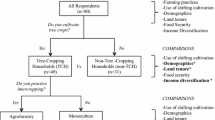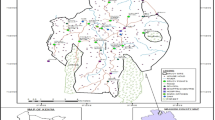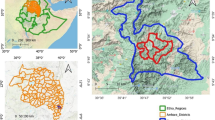Abstract
A mail-out survey questionnaire was developed by the Agroforestry group at the University of Guelph to determine the level of awareness and interest in the adoption of agroforestry systems by landusers from four townships in Wellington County, Ontario. The questionnaire investigated: (1) the current level of knowledge regarding windbreaks, woodlots and plantations, intereropping, riparian plantations and silvipasture, (2) the present level of participation in each of these systems on-farm, (3) the perceived benefits and/or drawbacks of each of these initiatives with respect to total farm income, income diversity, land rehabilitation, land value/equity, soil/water conservation, labour intensity, overhead and return on the term of investment.
The majority of respondents were familiar with conventional agroforestry systems such as windbreaks and woodlots/plantations (80%, 62% respectively), therefore the level of interest in the adoption of these practices was significant (74%, 66% respectively). Response rates were lower for silvipasture, riparian plantations and intercropping, most likely as result of the low level of familiarity with these practices (20%, 32%, 4% respectively). Respondents commented that agroforestry systems would have a neutral effect on farm income, and would increase land stewardship. In some cases, interested landusers indicated a willingness to participate in agroforestry systems even though they anticipated increases in overhead and labour intensity; however, this was only true if they held land stewardship as a priority. Landusers were more concerned with the economic aspects of agroforestry, as a determinant to the future adoptability of particular practices. Age, gender, farm operation and farm size were not correlated with the adoption of agroforestry systems.
The success of agroforestry programs on farms in the study area is largely dependent on the attitudes and willingness of landusers to participate in non-traditional agricultural systems.
Similar content being viewed by others
References
Ashton-Tate (1989) dBase IV software package
Gordon AM and Williams PA (1991) Intercropping valuable hardwood tree species and agricultural crops. For Chron 67 (3): 200–208
Gordon AM, Williams PA and Matthews S (1991) Agroforestry and its significance for sustainable development. In: Sanderson K, ed, Sustainable Use of Canada's Forests: Are We on the Right Path? Symposium sponsored by Can Soc Envir Bio, April 5–6, 1990, Kananaskis, Alberta, Canada, 29 pp
Filson GC (1990) Ontario's extension education requirements for sustainable agriculture. Extension Information Bulletin 44 (Summer 1990): 20–28
Loeffler AE, Gordon AM and Gillespie TJ (1992) Optical porosity and windspeed reduction by coniferous windbreaks in southern Ontario. Agroforestry Systems 17 (2): 119–133
Williams PA and Gordon AM (1992) The potential of intercropping as an alternative land use system in temperate North America. Agroforestry Systems 19: 253–263
Author information
Authors and Affiliations
Rights and permissions
About this article
Cite this article
Matthews, S., Pease, S.M., Gordon, A.M. et al. Landowner perceptions and the adoption of agroforestry practices in southern Ontario, Canada. Agroforest Syst 21, 159–168 (1993). https://doi.org/10.1007/BF00705227
Issue Date:
DOI: https://doi.org/10.1007/BF00705227




